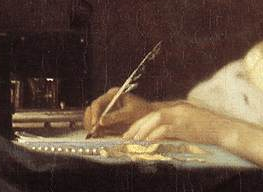Palatium : Court residences as places of exchange in late medieval and early modern Europe (1400-1700)
PALATIUM is a Research Networking Programme financed by the European Science Foundation. It brings together scholars from different fields across Europe to promote trans-disciplinary and trans-national research on Court Residences as Places of Exchange in Late Medieval and Early Modern Europe (1400-1700). During its five-year running period, from June 2010 to May 2015, PALATIUM will stimulate exchanges of knowledge and experience on this topic between historians, architectural historians, art historians and researchers from related disciplines in various meetings, workshops, conferences, and a summer school.
Aims and Objectives
The ESF Research Networking Programme PALATIUM aims at creating a common forum for research on the late medieval and early modern European court residence or “palace” (palatium) in an interdisciplinary perspective. The world of the courts 1400-1700 constituted a network of truly European scale and international character, but its architecture is only rarely studied in its “connectivity”. Here the “palace” is seen as a place for cultural exchange. Human interaction in this space is regulated and codified by a set of rules, known as the “ceremonial”. The interaction between palace architecture (tangible) and the ceremonial (intangible, but known through a set of tangible testimonials of different types, written and visual) is one of the key questions the PALATIUM network aims to address. The palace’s space and form carry multiple connotations. To the informed observer they represent power, lineage, and tradition versus innovation. The decoding of this system of signs necessitates input not only of architectural and art historians, but also of various other disciplines, such as archaeology, politics, literature, theatre and music. The PALATIUM programme specifically wants to encourage the debate on method in the field. It aims at stimulating exchanges of knowledge and experience between historians, architectural historians, art historians and researchers from related disciplines, while building up a network of scholars and institutes from a large number of European countries, so as to mirror the international network of courts that is being examined.
Detail of the Swiss Gate at the Hofburg Palace in Vienna, Austria (photo Pieter Martens 2009)
Topics and Working Parties
The PALATIUM network is structured in different “Working Parties” (WP), three of which concentrate on particular problems in time and place (WP 1-3), and three of which aim at developing the theoretical and methodological framework (WPM 1-3). Each working party organises particular workshops and colloquia (see the Events pages).
The first three working parties address problems of exchange and influence between various courts within different geographical or chronological areas.
WP1 – Valois, Burgundy and Tudor (1400-1550) : Exchanges and Influences ?
This working party addresses the enduring myth of the Burgundian court ceremonial and architecture by mapping the late fourteenth-century Valois context and by addressing the unsolved question of local influence in the new “Burgundian” lands acquired in the fifteenth century (i.e. the area of today’s Netherlands, Belgium, Northern France, Luxemburg and the Rhineland). In a comparative perspective, the courts of the last monarchs of the English house of York and of the early Tudors and Stewarts are looked at : the architecture shows features of possible French/Netherlandish/Burgundian origin, while its ceremonial equally obviously has “local” features. Similarly, the same questions must be answered regarding the Portuguese court.
– First event : Paris colloquium “Princes, Princesses” (28-30 June 2011)
WP2 – Habsburg Spheres (1500-1650) : Exchanges and Influences ?
The interaction between ceremonial and architecture in the Habsburg World has been studied for the Flemish residences and the Spanish, both inextricably linked ; however, the relationship with the courts in Central Europe is so far only sketchily known. This working party, with the ongoing research on the Hofburg in Vienna as its pivot, focuses on the palaces of the Burgundian-Spanish and Austrian lines of the Habsburgs in a comparative perspective. Relations with the palaces of the viceroys of the Spanish empire (in Italy, Portugal but also in the Americas and the East) ; the confrontation of “Habsburg” with “Valois” and “Tudor” in their sixteenth-century incarnation ; and with the Ottoman palace as a rival imperial model are also addressed.
– First event : Madrid colloqium “Felix Austria” (30 Nov. - 2 Dec. 2010)
WP3 – Network of Courts (1500-1700)
A dominant factor in international court life was the rivalry between Spain and France. The centuries-old quarrel between the Habsburg and the Valois/Bourbon monarchies about their seniority and precedence encouraged both sides to create a distinction in all kinds of aspects of courtly etiquette, ceremonies, and the architectural setting of court life. Other courts were obliged to take sides. Thus the architecture of the “satellite” courts at the “periphery” of the dominant rivals represents the alliances and ambitions of the European courtly elite. Princely courts such as the court of Orange in the 17th century, the courts in the Holy Roman Empire (e.g. the Palatine electors/Saxony/Bavaria), families linked with the imperial courts (e.g. lords of Hradec), the Italian courts (e.g. the Gonzaga, Savoy and Farnese linked with Habsburg ; the Este linked with Valois), the courts of the Jagiellon dynasty, must all come to terms with the dominant models, known through their ambassadors, as do the royal dynasties of Denmark, Scotland, Poland and Portugal. This working party, which indeed covers the whole of Europe, aims at examining this complex network of courts.
The following three WPMs are specifically meant to attract specialists in court studies (historians, art historians) ready to work with architectural historians in an interdisciplinary perspective, and to help develop new research methods or tools.
WPM1 – “Examples”, “Models”, “Influences” : the “Connectivity” between the European Court Residences
This working party will attempt to broaden the historical approach in a trans-disciplinary manner (e.g. network theory). Our interactive website www.courtresidences.eu serves as a working research tool, but also as a portal site establishing a connection between the many particular websites and databases in the field.
WPM2 – Heuristics in an Interdisciplinary Perspective
The source material of the architectural historian is by definition diverse, but in this particular field the range of methods needed can be daunting (e.g. ambassador’s reports as a source for close reading ; household and construction accounts as a source for quantitative analysis ; festive representation : patterns of visual culture). A particular problem, key to the whole project, is the (non-linear) relationship between the court ordinance and the spatial structure of the residence. Another, recently developed, field of interest is the relationship between the court residence and visual media (e.g. medallions).
– First event : Brussels seminar “Material Resources” (11 Oct. 2010)
WPM3 – Reconstructing the Palace as Virtual Heritage
Digital reconstructions have proven their usefulness in visualizing but also in clarifying data and research results (e.g. construction phases, ceremonial use). This working party will be open to researchers interested in the development of interactive 3D models (e.g. based on VRML or X3D standard), interactive websites and other mixed media forms of presentation as tools for representing palaces, with the specific aim of developing user-friendly ways of presenting the research in this field to the larger community.
Steering Committee
– Krista De Jonge (Chair) - Belgium
– Bernardo García García (co-Chair) - Spain
– Uwe Albrecht - Germany
– Monique Chatenet - France
– Ingrid Ciulisová - Slovak Republic
– Birgitte Bøggild Johannsen - Denmark
– Herbert Karner - Austria
– Ivan Prokop Muchka - Czech Republic
– Konrad Ottenheym - The Netherlands
– Fabian Persson - Sweden
– Nuno Senos - Portugal
Pour plus d’information, consultez le site du programme Palatium.




